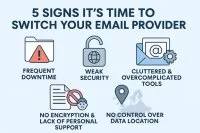Hassle-Free Email Migration
What happens when you have a large database of emails and you find yourself in need of updating your email platform? The process of email migration is one that might seem intimidating to some, but it is a fairly straightforward process as long as it is done properly.
What Is Email Migration?
The process of email migration involves the transfer of email data from one platform or provider to another. It can encompass a range of scenarios, such as migrating to a new email service provider, upgrading to a different email software version, or consolidating email accounts during a corporate merger or acquisition.
With that said, you should see that the primary objective is to preserve the integrity of email data while facilitating a seamless shift for all its users.
Benefits of Hassle-Free Email Migration
a. Heightened Efficiency: Modern email systems often come equipped with advanced features and functionalities that boost productivity, streamlining communication and collaboration within the organization.
- b. Cost-Effectiveness: Migrating to an optimal email service can result in long-term cost savings, as improved systems generally demand fewer resources and maintenance expenses.
- c. Enhanced Security: Upgrading to a new email service provider can provide enhanced security measures, safeguarding sensitive data from potential threats.
- d. Seamless Collaboration: Certain email platforms integrate collaborative tools that foster seamless teamwork and project management among employees.
Tips for Preparing Your Email Migration
- a. Assessment of Requirements: Understand the specific email needs of your organization, including user count, storage requirements, and essential features necessary for efficient operations.
- b. Data Backup: Prior to commencing the migration, ensure that all email data is thoroughly backed up to mitigate the risk of data loss during the process.
- c. Transparent Communication: Notify all users about the impending migration, elucidating its advantages, and proactively addressing potential disruptions during the transition.
- d. Formulate a Comprehensive Plan: Create a meticulously detailed migration plan, delineating each step, establishing a timeline, and assigning accountable personnel for their respective roles.
How to Choose the Right Email Migration Provider
- a. Experience and Expertise: Opt for providers with a proven track record of successful email migrations and demonstrable expertise in handling similar projects.
- b. Data Security Measures: Ensure that the chosen provider implements robust security measures to safeguard sensitive data throughout the migration process.
- c. Scalability: Select a provider capable of accommodating your organization's potential growth and evolving requirements.
- d. Customer Support: 24/7 customer support is essential to promptly address any issues or queries that may arise during the migration process.
Understanding the Migration Process
- a. Preparation Phase: This phase encompasses data backup, development of the migration plan, and thorough communication with all stakeholders.
- b. Testing Phase: Before executing the full-scale migration, conduct a test migration using a subset of users to identify and rectify any issues.
- c. Migration Execution: Upon successful completion of the test migration, proceed with the full-scale migration process.
- d. Verification and Testing: After migration, conduct verification processes and rigorous testing to ensure the accurate transfer of data.
Ensuring Data Security During Email Migration
- a. Data Encryption: Encrypt data during its transmission to protect it from unauthorized access.
- b. Access Control: Implement stringent access controls to restrict data access to authorized personnel only.
- c. Continuous Monitoring: Consistently monitor the migration process for any anomalies or potential security breaches.
Managing Email Migration Projects
- a. Appointing a Project Manager: Designate a capable project manager to oversee the entire migration process and ensure smooth coordination among stakeholders.
- b. Establishing Milestones: Divide the migration process into manageable milestones to monitor progress and address challenges effectively.
- c. Transparent Updates: Provide regular updates to all involved parties, keeping them informed of the project's progress and any modifications to the migration plan.
Best Practices for Hassle-Free Email Migration
- a. Thorough Planning: Engage in meticulous planning, allowing ample time for testing and addressing potential issues before executing the migration.
- b. User Training: Conduct comprehensive training sessions to familiarize users with the new email platform and its features.
- c. Comprehensive Data Backup: Ensure that data backup is diligently performed before initiating the migration process.
- d. Rigorous Testing: Conduct extensive testing to identify and resolve any potential complications before the migration's full execution.
Troubleshooting Email Migration Issues
Despite careful planning, unexpected issues may arise during the migration process. To mitigate their impact, consider the following measures:
- a. Contingency Planning: Develop a contingency plan to address unforeseen challenges promptly and effectively.
- b. Expert Assistance: Seek professional assistance from experienced individuals or organizations to resolve complex migration issues efficiently.
Post-Migration Challenges and Solutions
- a. Performance Monitoring: It is important to closely monitor the new email system for any performance issues and identify areas for improvement.
- b. User Support: You should also provide ongoing support to users during their adjustment to the new system, offering additional training and assistance when needed.
Final thoughts on email migration
In conclusion, email migration, though seemingly complex, can be quite easy to incorporate even when there are so many complex things happening in the background.

![]() © 2022 - 2025 HostingBe.com Simple CMS versie 3.1.0
© 2022 - 2025 HostingBe.com Simple CMS versie 3.1.0